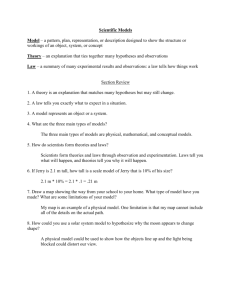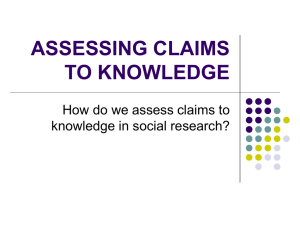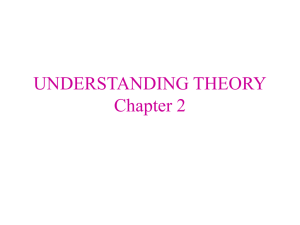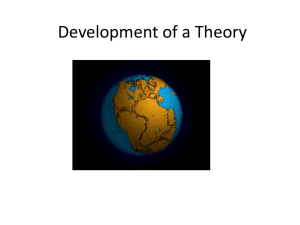Origins of Research Questions and Process
advertisement
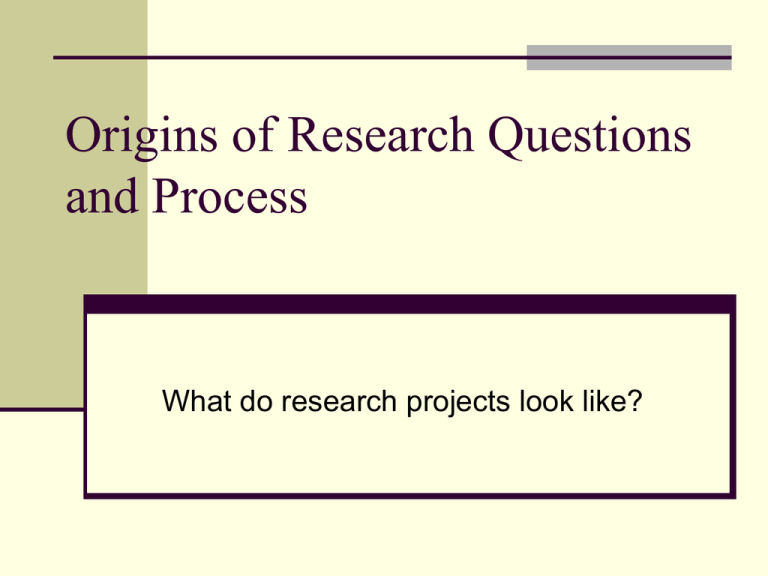
Origins of Research Questions and Process What do research projects look like? Types of social research 1. DESCRIPTIVE RESEARCH: (who, where, when and what) 2. EXPLORATORY RESEARCH: (Identifying patterns and relationships) 3. EXPLANATORY RESEARCH: (model development and testing) 4. EVALUATION RESEARCH: ( seeks to determine cause and effect of policy or programs) Research Process 1. 2. 3. 4. 5. 6. Identify Research Question. Review literature on that topic. Form theory and hypotheses if explanatory study. Construct Research Design. Test. Conclude: Review and Implications. Origin of Research Questions Real-World stimuli Curiosity Imagination Reformulation of research questions in a literature. Evaluation of Public Policies Even though we may be thinking theoretically by beginning to relate concepts to each other, we still need to make a professional jump to a scientific research program. This is a necessary step before we begin to more formally think about a problem and know we can make a contribution. How do we know we can make a contribution and how? Answer: Undertake a review of the literature. Purpose of Literature Reviews Lit reviews reveal the scientific community researching a given topic. In doing so establishes certain research questions as important (albeit sometimes subject to fads). Research questions should also be compelling to real world, naturally. To devise a research project without reviewing lit may result in redundant and insignificant research of interest to no one. Goals of A Lit Review 1. 2. 3. 4. 5. Again, identify a community of scholars. Establishes your work in this community. In doing so, survey variety of theories, methods, etc. in other work. Reformulate your question relative to other work. Form your work to be commensurate with others in regard to paradigms, conventions, theory, and data. Theory and Testing • Explanation relies on theory. What is a theory? A theory is a postulation based on logical suppositions that explain generalizations. Theories answer “Why” questions. With Theory we Generalize and Test • Using systematic methodologies and theories help us learn about the world. • We begin by describing our problem and then move on to explaining our phenomenon of interest. • We do this by constructing theories and testing them. Important traits of theories No theory can be completely correct. 2. Theories are simplifications of reality. 3. The goal is to seek general patterns. 4. Theories specify cause and effect relationships between variables. X causes Y Theories and Concepts Theories order concepts as variables specifying directional relationships. For example, education (X) increases income (Y). Income (X) increases chance and individual votes Republican (Y). We test our theories by testing hypotheses. Hypotheses are general propositions (assertions). For example, H1: Dictatorships get into more wars than democracies. The Hypothesis Testable Propositions linking theory to knowledge Hypotheses A hypothesis is a testable proposition that formalizes the expectations of a theory. It does this by stating the relationships of variables in a theory. One theory may produce several hypotheses, each tested singularly. Hypotheses continued Hypotheses are usually stated as direct or inverse relationships, especially if they are your own, and not the null. Hypotheses state how one variable affects another variable, in other words how the Dependent Variable is affected by an Independent Variable. We seek to discredit the Null Hypothesis, which states that there is no relationship between the two given variables. For Example: H1: State economic development increases democracy. Direct relationship (inverse relationship would be dev decreases dem) H0: There is no relationship between Economic development and democracy. (Null hypothesis, note not stated in negative or inverse) Which are the independent and dependent variables? Relationships between variables Y Direct or positive relationship No relationship Inverse or negative relationship 0 X Hypotheses continued The variable being affected is the dependent variable, and the affecter is the independent variable. Other names for dependent variable is the outcome variable or Y. Names for independent variables include explanatory, covariates, X. Cause & effect SINGLE CAUSE X SIMULTANEOUS CAUSE Y Y X MULTIPLE CAUSE INDIRECT CAUSE X1 X2 X3 Y X Z Y Issue of Causality It is common to say something causes something else, although we tend to use this word loosely. A proper synonym is AFFECT. Causality is a deep issue that cannot really be true in its most literal meaning, which would be deterministic and not suitable for social science. For example, Wealth causes Republican Party membership. (wealth=Republican) or wealthy individuals must be Republican!! Or Because Iraq has weapons of mass destruction, they will use them against the USA. Issue of Causality By cause, we usually mean that some variable AFFECTS another. It is best to use language and methods related to probability theory. How much does an increase in X affect Y, and how strong is this effect? The issue of Causality and lack of absolutism of science are similar. In the same way that we can not prove theories to be absolutely true, we can never be absolutely sure one variable is affecting another. For this reason, it is more appropriate to say that a X variable increases or decreases the likelihood of a change in the Y variable with some probability, even if very high or low. Correlative Hypotheses Hypotheses may also speculate about whether two variables are related but not venture a guess to which affects which. This is a question of association where correlation is useful, but is descriptive and not relational or explanatory. Education and wealth are highly related. Poverty and crime are related. Democracy and National Wealth are related. Research Design The next few weeks discuss matters of research design and later the evaluation and interpretation of results.
